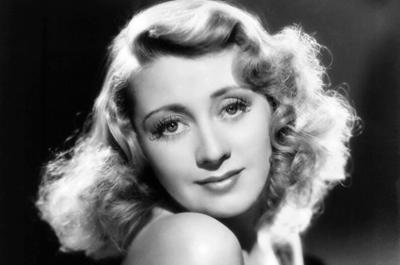Victoria Wilson’s biography of Barbara Stanwyck is titled Steel-True; if Stanwyck was all steely integrity, her friend and occasional co-star, Joan Blondell (1906-79), might have been likened to gleaming brass. As a comedian, entertainer, and dramatic actor, Blondell mirrored Stanwyck’s independence, especially during the Pre-Code cinema era of the early 1930s.
The Criterion Channel offers a baker’s dozen of Blondell’s films, released from 1931-34. These are brief, fast flicks — Big City Blues (1931), for example, is just over an hour long. They can be consumed in fistfuls, like peanuts.
Born into a New York City vaudeville family, Blondell parlayed her theatrical experiences playing chorines, waitresses, and girls in search of a fast buck and a square meal. She worked long enough to play Vi, the waitress at the Frosty Palace in Grease (1978) — and considering John Travolta and Olivia Newton-John can currently be seen cavorting at half the drive-ins in America, Blondell is still very much alive on screen. On the windward side of age 60 on television’s Here Come the Brides (1968-70), Blondell still had the insouciance, the succulent lower lip, and the curves she displayed in those risqué early sound films.
I’ve seen very few scantily-clad pin up pictures of Blondell in which she didn’t look like she was gritting her teeth — the famous one where she’s lounging in the bathtub in Blonde Crazy is an exception. But her figure was certainly part of her appeal. Leonard J. Leff and Jerod L. Simmons’ history of Hollywood censorship, The Dame in the Kimono, quotes a story about the since-lost 1933 film Convention City. Worrying about how it would be received in the Bible belt, Warner Brothers studio head Jack Warner set a memo to producer Hal Wallis: “We must put brassieres on Joan Blondell and make her cover her breasts… don’t let those bulbs stick out!”
Blondell — it was her birth name, stagey though it sounds — had the kind of blonde hair that gleamed in the hot lights of a movie studio. She’d give those round, suggestive eyes a good roll, as fedora-wearing city slickers put the moves on her. In Other Men’s Women (1931), Blondell describes herself as an “A.P.O” — “ain’t puttin’ out.”
The 13 films here are mostly Warner Brothers/First National pictures, cranked out on tight schedules of two or three weeks. Despite the assembly line dynamics, Blondell worked for first rate directors, such as William Wellman and Howard Hawks. Hawks’ 1932 hit The Crowd Roars, co-scripted by San Francisco’s Niven Busch, is one of the seven films she made co-starring with James Cagney.
Hawks mastered all film genres, and the least interesting of these was the race car movie. Still “eight world famous racing drivers” (according to the credits) and authentically harrowing accidents liven up a plot about a spotlessly dressed Indianapolis 500 champ (Cagney) and his too-good-to-live little brother; Blondell here is merely the lady who distracts him.
Wellman’s riveting Night Nurse (1931) is a better showcase for her. Blondell and Stanwyck star as a duo of New York night-nannies protecting a pair of children against killers. In Three on a Match (1932) Blondell is the moral center of a trio of school girls who grew to be adults; husky-voiced Ann Dvorak and a young Bette Davis are the other two.
The entertaining and breezy Blondie Johnson (1933) parallels Stanwyck’s Baby Face, made during that same year. Blondell’s Virginia “Blondie” Johnson turns up in the opening, in laddered stockings and a rain-soaked cloche hat, getting turned down for welfare. Her mother dies of pneumonia after she is evicted during a rainstorm. Blondie is warned off from taking the path of vengeance against society by a priest: “There’s two ways to make money…”
Blondell snaps back, “Yeah! The hard way and the easy way!”
First, she has a turn as a short-con artist before landing the job of assistant — but not a moll — to Danny Jones (Chester Morris), the right-hand man of the city’s crime boss. One of her exploits involves jury tampering, in a method later parodied in the great Ginger Rogers comedy Roxie Hart: using what a character calls ”those big shiny eyes of hers” for maximum effect.
In the peppery1931 Blonde Crazy, Blondell is a towel girl at some Midwestern hotel; she meets Bert, a snazzy bellboy (Cagney) with ambitions. (There were opportunities for enterprising bellhops in those days, especially the ones that knew where the speakeasies could be found and the ladies could be rented.) Bert has a scrapbook full of grifts reported in the newspaper; using that as a guidebook, the two work their way up from fast hustles to bigger scores. It’s laden with details that the upcoming Production Code would soon quash… such as a scene of Cagney making a great show of examining Blondell’s satin underwear while whistling “Happy Days Are Here Again.”
Blonde Crazy is directed by Roy del Ruth, who made the best version of The Maltese Falcon. His career exemplifies an era when films were made as quickly as possible — with time and raw film stock costing money. The editing might be faster in a 2020 movie, but the pace is faster in these opuses from 90 years ago. They scuttle along, with whip-pans, wipes of every description (clock, diagonal, you name it) and short-hand tough-guy dialogue. In Blonde Crazy, Cagney sums up a year of his life in one word to a pal, who asks him, “How was Europe?”
“Stinks.”
Short as these films are, if you look away, you get lost. Lawyer Man (1932)is more of a William Powell flick than a showcase for Blondell. Imagine a 1930s Saul Goodman. That’s Anton Adam, who gets recruited out of his dingy Lower East Side law office to the 49th floor of a midtown skyscraper. His loyal secretary Blondell smells a rat. The rodents soon materialize, in the form of representatives from the political machine who want the lawyer to get along, to go along. When thugs show up to reinforce the lesson, Adams feeds them cake and cocktails and sends them on their way. It’s a brisk comedy, with Powell showing off the rapidity and magnetism that made him a star in the Thin Man series.
Blondell, who always described herself as a workhorse, never really got the salary she deserved. But she started to appear in more ambitious pictures. The surprise in this Criterion series is 1934’s He Was Her Man, a leisurely romance with expensive locations at Carmel Mission, Point Lobos and Monterey.
Cagney (with an unflattering pencil-thin mustache) is a New York gangster on the run in San Francisco. In his hotel, he meets Blondell, as a poor girl stuck without the fare to get to Santa Avila, an imaginary off-the-track fishing village. There, her Portugeuese fiance (Victor Jory, in desperate need of a dialect coach) waits for her. Cagney and Blondell travel together and fall in love, but fate tails this ex-con no matter where he runs.
He Was Her Man has plot holes the size of Ausable Chasm, but the more leisurely approach suits Blondell’s style. She’s often very touching. There are moments when He Was Her Man looks like a doom-laden French gangster romance, the sort that starred Jean Gabin.
Three Busby Berkeley early musicals turn up in this Blondell series, all co-starring the peppy juvenile Dick Powell, whom Blondell eventually married. Berkeley was the drill-instructor turned choreographer who did proto-psychedelic numbers that anticipate the marching band half-time show, here with dancers forming geometric forms, the National Recovery Act eagle, or the face of the musical’s regular star, Ruby Keeler.
Dames (1934)is the one where Blondell is trying to dance with the model for Elmer Fudd, the plump Guy Kibbee — “Oh, you’re as light as a heifer, I mean, feather,” Blondell says as he trods on her toes.
Footlight Parade (1933) imagines what the life of director Berkeley might be like. The Berkeley figure is named Chester Kent (Cagney) a producer of “musical spectaculars” — like the Lawyer Man Anton Adam, Chester is a workaholic too busy to notice Blondell, that loyal girl right by his side, with the heart as gold as her hair, and an excellent nose for malarkey.
The Berkeley numbers are jaw-dropping. Nothing can out-weird 2019’s Cats — “the body-horror on display makes Cronenberg look quaint,” as that lyric in the Honest Previews video has it. But close on Cats’ impeccable weirdness is Footlight Parade’s cat-suited “Sitting On a Backyard Fence”. Similarly baroque is the rendition of “By A Waterfall,” one of the unsung hydrological projects of the 1930s: it’s staged in a 20,000 gallon tank, and a 70 foot artificial waterfall covered with nymphs, who perform one of the first aqua ballets on screen.
These musicals gave Blondell a chance to show off her wit and insouciance, but she goes deeper in Gold Diggers of 1933. In the dark “Remember My Forgotten Man” sequence, Blondell plays a street prostitute speak-singing the Dubin and Warren lyrics, as an opening for the African-American singer Etta Moten to belt out that bluesy tune:
Remember my forgotten man
You put a rifle in his hand
You sent him far away
You shouted: ‘Hip-hooray!’
But look at him today…
Everyone from Franklin Roosevelt to Donald Trump has used the phrase “the forgotten man” in their speeches to describe those left-out of prosperity. These Blondell comedies and dramas are the Great Depression speaking to our own financial trough; the hard-shelled, soft-centered heroine is as fresh now as she was then.









